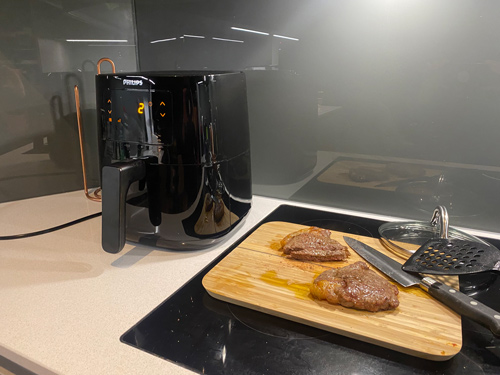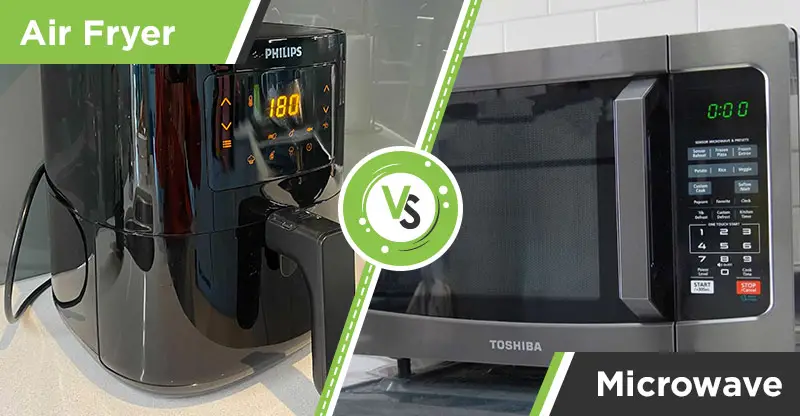Have you ever wondered about the differences between an air fryer and microwave?
If so, maybe you are wondering what the actual differences are between the two appliances. It seems like every house, apartment, dorm room, camper van, and even office kitchen has a microwave.
One could argue that they are one of the most well known and used kitchen appliances. Yet, with the trendy emergence of air fryers, you may be wondering if one can replace the other.
The answer is:
Because air fryers and microwaves have fundamentally different cooking methods, they differ in design, health, power consumption, and even food taste. You may find solace in the fact that you don’t actually need to choose one or the other!
The decision in choosing which appliance to buy for your home, and under which circumstances, can be a stressful experience.
This article aims to explain the differences between air fryers and microwaves and give you the positives of having each in your home.
After reading, you'll feel more at ease with which kitchen appliance to use because you will understand each tool’s upsides and downsides.
Comparison Chart: Air Fryer VS. Microwave
To make comparing and contrasting easier, I’ve whipped up a quick little comparison chart for you to note the key differences:
Feature | Air Fryer | Microwave |
|---|---|---|
Cooking Method | Cooks food via convection heating | Cooks food by rapidly vibrating water molecules within food1 |
Design and Aesthetic | Square with different chambers or compartments inside | Usually rectangular with one inner chamber or compartment |
Power Consumption | Anywhere from 1200-1500 watts for approximately 15-20 minutes of cooking | Up to 1200 watts for approximately 30-40 minutes of cooking |
Health | Convection heating is overall a healthy way to cook food | Microwaving is also a healthy way to cook food |
Food Taste | Can leave food dry on the outside | Can leave food tasteless |
The Key Differences Between the Air Fryer and Microwave
Let’s look more in-depth at how their features are different.
1. Cooking Techniques
The ways in which air fryers and microwaves cook food differ significantly.
In fact, one can argue that microwaves don’t really even cook food. This is a common misconception. Microwaves can cook food but they are mainly used to reheat food.
Though you can reheat foods, like burritos, without a microwave!
Air Fryer:
Air fryers are ingenious cooking appliances. All air fryers use convection technology to cook food via moving around very hot air inside a small compartment.
The science behind this is pretty simple:
Air fryers have coils in them that fiercely heat up. After the coil heats up, the fan starts and begins to move the hot air around.
The food in an air fryer sits in a perforated container, to allow the air to go through. Which then creates the coveted “Maillard Reaction” giving food that famously decadent brown crisp.
Microwave:
Microwaves work in a different fashion.
The word itself says it all — tiny waves or “microwaves” go through the food, vibrating the water molecules. As the molecules increase in movement, they start to generate heat.
This heat then is what cooks the food inside the microwave.
2. Design and Aesthetic
Aside from differing cooking techniques, the overall cooking interface on the two appliances differs quite a bit. The design and aesthetic of each appliance are unique.
Air Fryer:
With an air fryer it is normal to frequently change the temperature and the cooking time. When I cook with my air fryer, I change up the settings every time I cook.
Air fryers also tend to be more square than microwaves. Depending on the size of the air fryer, they can also be bulky and take up a significant amount of counter space.
If you’re looking for an air fryer that doesn’t take up too much room, read our article Philips Air Fryer VS Nuwave [Comparison Charts + Which One To Buy!] to see which is best for your home.
Microwave:
The interface of a microwave has less variety than an air fryer.
For example, you are able to change the wattage on a microwave rather than adjust it’s temperature settings (like in an air fryer).
Microwaves also are more rectangular and sometimes are incorporated into the kitchen in a way air fryers are not (e.g., built-in over your stovetop).
3. Overall Power Consumption
It’s always important to consider how much power a new appliance is going to use in your home.
Air Fryer:
Air fryers usually come at specific wattages.
For example, my Philips air fryer is 1400 watts. On an average day, I use my air fryer for about five to ten minutes. I do a variety of different things like reheat food and cook meals for the family.
Although they cook for less time, what most people don’t realize is that air fryers are less energy efficient than microwaves.
To learn more about air fryer power consumption, read our article: How Many Watts Does An Air Fryer Use? [Quick Answer and Cooking Tips].
Microwave:
Microwaves use less wattage, and over time they use less power.
In a microwave, only the food, plate, and area inside the microwave use up energy. For stovetops, the area must reach a certain temperature first before any cooking happens.
Another key element is that microwaves don’t conduct a large heat load for one’s air conditioning over the summertime.
4. Health
Health is wealth. You know it’s vital to take care of your health and the best way to do it is by eating nutritious foods cooked in healthful ways.
Air Fryer:
Air fryers, overall, are a healthy way to cook food. The cooking happens via convection heating and little oil is necessary for food. In the Philips air fryer this is called “rapid air technology.”
With air fryers, you need little to no oil on the food which in turn makes it a healthier alternative to deep frying. The cooking times are also shorter, which means that less nutritional value leaches out of the food during cooking.
Learn more: Can You Put Oil In An Air Fryer? [How To Do It & FAQ]
Microwave:
Another common misconception is that microwaving is an unhealthy means to cook food.
This is also not true. As a doctor from Harvard Health Publishing states, there is no evidence that microwaves are harmful to one’s body.
Chef’s tip:
Whenever you heat food, there will always be some nutritional breakdown. Because microwaves have shorter cooking times, using one can actually be advantageous for nutritional reasons.
5. They Alter Food Taste in Different Ways
Lastly, let’s look at how the different cooking methods alter the final flavor of your food.
Air Fryer:
Air fryers are my favorite cooking tool because they cook food evenly without drying out the center. The outside remains crispy and golden and the inside is moist and decadent.
The meal that comes to mind is my weekly salmon and rice.
Microwave:
Because the food is absorbing the electromagnetic waves, it can sometimes leave dry patches on your meal.
When cooking with a microwave, you will need to heat it for a few minutes and then take the food out to stir it. This will more evenly distribute the heat.

Personal image of my cooked steak in an air fryer
Upsides of Using an Air Fryer
There are two really great pros of choosing an air fryer for your home.
Air Fryers are a Healthier Way to Cook:
Because you use little to no oil in an air fryer, this makes them an appealing and healthy alternative to traditional cooking techniques.
Air Fryers Make Food Taste Delicious:
There is almost no contesting this point. Air fryers have an inexplicable way of leaving food deliciously golden on the outside but moist on the inside.
Downsides of Using an Air Fryer
On the other hand, there are two cons to air fryers.
Air Fryers can be Expensive:
Air fryers can come in different sizes. If you decide to purchase a larger one, then it can come at a cost… literally!
Did you just buy an air fryer but aren’t certain how to use it? Discover: How to Use Philips Air Fryer for the First Time
Air Fryers can be Bulky:
They are fairly square appliances and can take up some space on your kitchen counter.
Upsides of Using a Microwave
There are clear benefits to using a microwave to prepare your meals.
Microwaves are Energy Efficient:
This is because microwaves directly heat up the water inside food. The heat energy transfer percentage is a lot higher than heating food on a stovetop.
Microwaves Cook Food Quickly:
Once again, this is because microwaves do a great job at heating up the water molecules inside food and making them vibrate, which causes heat.
Most Residences Already have a Microwave:
According to Statista, in 2018 around 93% of American households contain a microwave. You rarely have to buy a new one!
Microwaves are Inexpensive:
However, if you do need to buy a new one, they’re quite affordable. Check out this Amazon’s choice microwave on Amazon.
Downsides of Using a Microwave
Here are the cons of using a microwave to reheat your meals.
Microwaves May Ruin the Flavor of Your Meal:
They have a tendency to dry out food.
Microwaves Aren’t Suitable for Cooking Raw Meat:
Penetrating foods is difficult in a microwave.
Which Foods Should I Cook with Which Appliance?
I’ve made this nifty navigation chart to help you determine which common foods are better suited to which appliance.
Food | Air Fryer | Microwave |
|---|---|---|
Steak | Yes, you can cook and reheat. It will come out delicious! | I do not recommend using a microwave for this. |
Eggs | Not suitable to melt butter. However, you are able to spread it on top of food inside the air fryer. | Yes, you can make fast scrambled eggs in a microwave! |
Butter | Not suitable to melt butter. However, you are able to spread it on top of food inside the air fryer. | Yes, you can easily melt butter in the microwave |
Water | No, air fryers will not allow for you to heat up water for a hot drink | Yes, with a microwave you can easily heat up a mug of water to add to your favorite tea or instant coffee. |
Related: How To Fry an Egg Without Oil or Butter?
Conclusion: Which Appliance is Better?
There is no right or wrong answer here. The type of appliance that you use depends on the meal you are making.
Air fryers are perfect for any dorm room or small counter top setting. Microwaves usually take up more space, but are great to use if you’re heating up leftovers. We can go back and forth discussing the perks of one and the downfalls of the other.
In reality, both appliances offer an immense amount in terms of functionality and so all households would benefit by having them both!
Personally, I am very content having both in my household. I reap the benefits by being able to cook and prepare a wide variety of meals and goodies — not just for myself but also for family and friends.
- How to Reheat Taco Bell [Best 5 Methods] - January 20, 2022
- What is the Most Expensive Titanium Cookware? [& Which One to Buy] - January 18, 2022
- The Best Air Fryer With Dehydrator Function [With Top Tips & Food Ideas] - December 12, 2021

